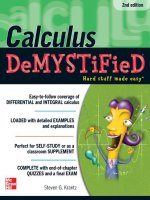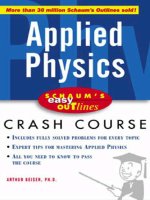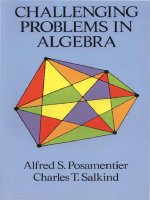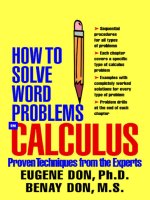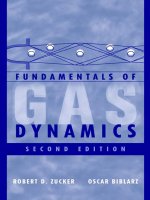Schaum beginning calculus 2e elliott mendelson
Bạn đang xem bản rút gọn của tài liệu. Xem và tải ngay bản đầy đủ của tài liệu tại đây (19.63 MB, 390 trang )
SCHAUM'S OUTLINE SERIES
Schaum's Outline of Theory and Problems of Beginning
Calculus
Second Edition
Elliott Mendelson, Ph.D.
Professor of Mathematics
Queens College
City University of New York
www.pdfgrip.com
To the memory of my father, Joseph, and my mother, Helen
ELLIOTT MENDELSON is Professor of Mathematics at Queens College of the City University of
New York. He also has taught at the University of Chicago, Columbia University, and the University of
Pennsylvania, and was a member of the Society of Fellows of Harvard University. He is the author of
several books, including Schaum's Outline of Boolean Algebra and Switching Circuits. His principal
area of research is mathematical logic and set theory.
Schaum's Outline of Theory and Problems of
BEGINNING CALCULUS
Copyright © 1997,1985 by The McGraw-Hill Companies, Inc. All rights reserved. Printed in the United
States of America. Except as permitted under the Copyright Act of 1976, no part of this publication
may be reproduced or distributed in any form or by any means, or stored in a data base or retrieval
system, without the prior written permission of the publisher.
5 6 7 8 9 10 11 12 13 14 15 16 17 18 19 20 PRS PRS 9 0 1 0 9
ISBN 0-07-041733-4
Sponsoring Editor: Arthur Biderman
Production Supervisor: Suzanne Rapcavage
Editing Supervisor: Maureen B. Walker
Library of Congress Cataloging-in-Publication Data
Mendelson, Elliott.
Schaum's outline of theory and problems of beginning calculus /
Elliott Mendelson, -- 2nd ed.
p. cm. -- (Schaum's outline series)
Includes index.
ISBN 0-07-041733-4 (pbk.)
1. Calculus. 2. Calculus--Problems, exercises, etc. I. Title.
QA303.M387 1997
515' .076--dc21
96-39852
CIP
www.pdfgrip.com
Preface
This Outline is limited to the essentials of calculus. It carefully develops, giving all steps, the principles
of differentiation and integration on which the whole of calculus is built. The book is suitable for
reviewing the subject, or as a self-contained text for an elementary calculus course.
The author has found that many of the difficulties students encounter in calculus are due to weakness in
algebra and arithmetical computation, emphasis has been placed on reviewing algebraic and
arithmetical techniques whenever they are used. Every effort has been made—especially in regard to
the composition of the solved problems—to ease the beginner's entry into calculus. There are also some
1500 supplementary problems (with a complete set of answers at the end of the book).
High school courses in calculus can readily use this Outline. Many of the problems are adopted from
questions that have appeared in the Advanced Placement Examination in Calculus, so that students will
automatically receive preparation for that test.
The Second Edition has been improved by the following changes:
1. A large number of problems have been added to take advantage of the availability of graphing
calculators. Such problems are preceded by the notation
. Solution of these problems is not
necessary for comprehension of the text, so that students not having a graphing calculator will not
suffer seriously from that lack (except insofar as the use of a graphing calculator enhances their
understanding of the subject).
2. Treatment of several topics have been expanded:
(a) Newton's Method is now the subject of a separate section. The availability of calculators makes
it much easier to work out concrete problems by this method.
(b) More attention and more problems are devoted to approximation techniques for integration, such
as the trapezoidal rule, Simpson's rule, and the midpoint rule.
(c) The chain rule now has a complete proof outlined in an exercise.
3. The exposition has been streamlined in many places and a substantial number of new problems have
been added.
The author wishes to thank again the editor of the First Edition, David Beckwith, as well as the editor of
the Second Edition, Arthur Biderman, and the editing supervisor, Maureen Walker.
ELLIOTT MENDELSON
www.pdfgrip.com
This page intentionally left blank
www.pdfgrip.com
Contents
Chapter 1
Coordinate Systems on a Line
1
1.1 The Coordinates of a Point
1
1.2 Absolute Value
2
Chapter 2
Coordinate Systems in a Plane
8
2.1 The Coordinates of a Point
8
2.2 The Distance Formula
9
2.3 The Midpoint Formulas
10
Chapter 3
Graphs of Equations
14
Chapter 4
Straight Lines
24
4.1 Slope
24
4.2 Equations of a Line
27
4.3 Parallel Lines
28
4.4 Perpendicular Lines
29
Chapter 5
Intersections of Graphs
36
Chapter 6
Symmetry
41
6.1 Symmetry about a Line
41
www.pdfgrip.com
6.2 Symmetry about a Point
42
Chapter 7
Functions and Their Graphs
46
7.1 The Notion of a Function
46
7.2 Intervals
48
7.3 Even and Odd Functions
50
7.4 Algebra Review: Zeros of Polynomials
51
Chapter 8
Limits
59
8.1 Introduction
59
8.2 Properties of Limits
59
8.3 Existence or Nonexistence of the Limit
61
Chapter 9
Special Limits
67
9.1 One-Sided Limits
67
9.2 Infinite Limits: Vertical Asymptotes
68
9.3 Limits at Infinity: Horizontal Asymptotes
70
78
Chapter 10
Continuity
10.1 Definition and Properties
78
10.2 One-Sided Continuity
79
10.3 Continuity over a Closed Interval
80
www.pdfgrip.com
Chapter 11
The Slope of a Tangent Line
86
Chapter 12
The Derivative
92
Chapter 13
More on the Derivative
99
13.1 Differentiability and Continuity
13.2 Further Rules for Derivatives
Chapter 14
Maximum and Minimum Problems
99
100
104
14.1 Relative Extrema
104
14.2 Absolute Extrema
105
Chapter 15
The Chain Rule
116
15.1 Composite Functions
116
15.2 Differentiation of Composite Functions
117
Chapter 16
Implicit Differentiation
126
Chapter 17
The Mean-Value Theorem and the Sign of the Derivative
129
17.1 Rolle's Theorem and the Mean-Value Theorem
129
17.2 The Sign of the Derivative
130
www.pdfgrip.com
Chapter 18
Rectilinear Motion and Instantaneous Velocity
136
Chapter 19
Instantaneous Rate of Change
143
Chapter 20
Related Rates
147
Chapter 21
Approximation by Differentials; Newton's Method
155
21.1 Estimating the Value of a Function
155
21.2 The Differential
155
21.3 Newton's Method
156
Chapter 22
Higher-Order Derivatives
161
Chapter 23
Applications of the Second Derivative and Graph Sketching
167
23.1 Concavity
167
23.2 Test for Relative Extrema
169
23.3 Graph Sketching
171
Chapter 24
More Maximum and Minimum Problems
179
Chapter 25
Angle Measure
185
25.1 Arc Length and Radian Measure
185
26.2 Directed Angles
186
www.pdfgrip.com
Chapter 26
Sine and Cosine Functions
190
26.1 General Definition
190
26.2 Properties
192
Chapter 27
Graphs and Derivatives of Sine and Cosine Functions
202
27.1 Graphs
202
27.2 Derivatives
205
Chapter 28
The Tangent and Other Trigonometric Functions
214
Chapter 29
Antiderivatives
221
29.1 Definition and Notation
221
29.2 Rules for Antiderivatives
222
Chapter 30
The Definite Integral
229
30.1 Sigma Notation
229
30.2 Area under a Curve
229
30.3 Properties of the Definite Integral
232
Chapter 31
The Fundamental Theorem of Calculus
238
31.1 Calculation of the Definite Integral
238
31.2 Average Value of a Function
239
31.3 Change of Variable in a Definite Integral
240
www.pdfgrip.com
Chapter 32
Applications of Integration I: Area and Arc Length
249
32.1 Area between a Curve and the y-axis
249
32.2 Area between Two Curves
250
32.3 Arc Length
251
Chapter 33
Applications of Integration II: Volume
257
33.1 Solids of Revolution
257
33.2 Volume Based on Cross Sections
259
Chapter 34
The Natural Logarithm
268
34.1 Definition
268
34.2 Properties
268
Chapter 35
Exponential Functions
275
35.1 Introduction
275
35.2 Properties of ax
275
35.3 The Function ex
275
Chapter 36
L'Hôpital's Rule; Exponential Growth and Decay
284
36.1 L'Hôpital's Rule
284
36.2 Exponential Growth and Decay
285
www.pdfgrip.com
Chapter 37
Inverse Trigonometric Functions
292
37.1 One-One Functions
292
37.2 Inverses of Restricted Trigonometric Functions
293
Chapter 38
Integration by Parts
305
Chapter 39
Trigonometric Integrands and Trigonometric Substitutions
311
39.1 Integration of Trigonometric Functions
311
39.2 Trigonometric Substitutions
313
Chapter 40
Integration of Rational Functions; The Method of Partial Fractions
320
Appendix A
Trigonometric Formulas
329
Appendix B
Basic Integration Formulas
330
Appendix C
Geometric Formulas
331
Appendix D
Trigonometric Functions
332
Appendix E
Natural Logarithms
333
Appendix F
Exponential Functions
334
Answers to Supplementary Problem
335
Index
371
www.pdfgrip.com
This page intentionally left blank
www.pdfgrip.com
Chapter 1
Coordinate Systems on a Line
1.1 THE COORDINATES OF A POINT
Let 9 be a line. Choose a point 0 on the line and call this point the origin.
Now select a direction along 9;
say, the direction from left to right on the diagram.
For every point P to the right of the origin 0, let the coordinate of P be the distance between 0 and P.
(Of course, to specify such a distance, it is first necessary to establish a unit distance by arbitrarily
picking two points and assigning the number 1 to the distance between these two points.)
In the diagram
the distance
is assumed to be 1, so that the coordinate of A is 1. The point B is two units away from
0; therefore, B has coordinate 2. Every positive real number r is the coordinate of a unique point on 9
to the right of the origin 0; namely, of that point to the right of 0 whose distance from 0 is r.
To every point Q on 9to the left of the origin 0,
-
we assign a negative real number as its coordinate; the number -Q0,the negative of the distance
between Q and 0. For example, in the diagram
the point U is assumed to be a distance of one unit from the origin 0; therefore, the coordinate of U is
- 1. The point W has coordinate -4, which means that the distance
is *. Clearly, every negative
real number is the coordinate of a unique point on 9 to the left of the origin.
The origin 0 is assigned the number 0 as its coordinate.
1
www.pdfgrip.com
2
COORDINATE SYSTEMS ON A LINE
[CHAP. 1
This assignment of real numbers to the points on the line 9is called a coordinate system on 9.
Choosing a different origin, a different direction along the line, or a different unit distance would result
in a different coordinate system.
1.2 ABSOLUTE VALUE
For any real number b define the absolute value I b I to be the magnitude of b; that is,
b
-6
lbl=
ifb20
ifb
In other words, if b is a positive number or zero, its absolute value I b I is 6 itself. But if b is negative, its
absolute value I b I is the corresponding positive number - b.
EXAMPLES
Properties of the Absolute Value
Notice that any number r and its negative - r have the same absolute value,
Irl = 1-4
An important special case of (1.1) results from choosing r
(1.1)
=U
- U and recalling that
-(U
- U) = U
(14
lu - U1 = l u - U1
If I a I
=
- U,
I b I, then either a and b are the same number or a and b are negatives of each other,
lal = lbl
implies a = + b
Moreover, since I a I is either a or -a, and ( -a)’ = a’,
la12
Replacing a in (14 ) by ab yields
(1.4)
= a‘
I ab l2 = (ab)2 = a2b2= I U 1’ I b 1’
(1 -3)
= (I U I I b I)’
whence, the absolute value being nonnegative,
lab1 = lallbl
Absolute Value and Distance
Consider a coordinate system on a line 9 and let A, and A2 be points on 9 with coordinates a,
and a 2 . Then
I a , - a2 I = A , A 2 = distance between A , and A2
www.pdfgrip.com
(1.6)
CHAP. 13
3
COORDINATE SYSTEMS ON A LINE
EXAMPLES
.
0
1
2
I
.
.
,
-2
-3
-1
1
1
I
1
U
1
5
A2
1
2
3
1
I
1
1
I
1
4
I
PY
I
AI
0
-
,Y
.
0
U
A2
4
I
AI
0
. . .
3
,
= 14 - (
41
= 14 4- 31 = 171 = 7 = A1A2
A special case of (1.6) is very important. If a is the coordinate of A, then
I a I = distance between A and the origin
Notice that, for any positive number c,
lul
1
I c is equivalent to
1
1
0
C
1
1
-C
*Y
1
EXAMPLE lul S 3 ifand only if -3 I
Similarly,
-c Iu Ic
I 3.
U
lul
< c is equivalent to
-c
(1.9)
EXAMPLE To find a simpler form for the condition I x - 3 I < 5, substitute x - 3 for U in (1.9), obtaining
- 5 < x - 3 < 5. Adding 3, we have - 2 < x < 8. From a geometric standpoint, note that I x - 3 I < 5 is equivalent
to saying that the distance between the point A having coordinate x and the point having coordinate 3 is less than 5.
I
I
1
I
-2
3
8
1
Y
1
It follows immediately from the definition of the absolute value that, for any two numbers a and b,
-1al I a
(In fact, either a = I a I or a =
-1
and
I lal
a I.) Adding the inequalities, we obtain
(-14) + ( - l b l )
+ 6 and c = lal
Ia
161)IU
+ Ibl,
-(lal+
and so, by(1.8), with u = a
-161 I6 Ilbl
l a + 61
+ b 2s I 4 + l b l
+ 6 I l a l + lbl
l a l + 161
(1.10)
The inequality (1.10) is known as the triangle inequality. In (1.20) the sign c applies if and only if a and
b are of opposite signs.
EXAMPLE 13
+ (-2)(
= 11 I = 1, but 131
+ 1-21
=3
+ 2 = 5.
www.pdfgrip.com
4
COORDINATE SYSTEMS ON A LINE
[CHAP. 1
Solved Problems
1.1
&
,/m;
Recalling that
always denotes the nonnegatiue square root of
(c) show that ,/? = Ix I. (d)Why isn’t the formula
ate
f l =Jd
fi
4-
U, (a) evaluate f l ;
(b) evalup=
x always true?
(c) By (1.4), x2 = Ix 1;’ hence, since Ix I 2 0,
(b)
=
= 3.
= 3.
= Ix I.
(d) By part (c), ,/? = I x I, but I x I = x is false when x < 0. For example,
=
= 3 # - 3.
(a)
1.2
Solve I x
+ 31 5 5 if and only if -5
Solve I3x
5x
+ 3 5 5. Subtracting 3, -8
1
I
5 x 5 2.
1
I
1
1
-8
0
2
+ 2 I < 1.
+
By (1.9), I3x + 2 I < 1 is equivalent to - 1 < 3x 2 < 1. Subtracting 2, we obtain the equivalent relation - 3 < 3x < - 1. This is equivalent, upon division by 3, to - 1 < x < - 3.
b
1
I
- 113
-1
1.4
fi
+ 3 I 5 5; that is, find all values of x for which the given relation holds.
By (1.8), I x
1.3
,/-
0
Solve 15 - 3x I < 2.
By (1.9), - 2 < 5 - 3x < 2. Subtracting 5, - 7 < - 3x < - 3. Dividing by - 3,; > x > 1.
~
~
~
ALGEBRA REVIEW Multiplying or dividing both sides of an inequality by a negative number reuerses the
inequality: if U < b and c < 0, then uc > bc.
To see this, notice that a < b implies b - a > 0. Hence, (b - U)C < 0, since the product of a positive
number and a negative number is negative. So bc - ac < 0, or bc < ac.
1
I
I
0
1.5
1
1
I
2
1
1
.
b
7
3
x+4<2
Solve
x-3
We cannot simply multiply both sides by x - 3, because we do not know whether x - 3 is positive or
negative.
Case 1: x - 3 > 0.Multiplying ( 1 ) by this positive quantity preserves the inequality:
x
+ 4 < 2~ - 6
4
10 < x
[subtract x]
[add 61
Thus, if x > 3, (1)holds if and only if x > 10.
Case 2: x - 3 < 0.Multiplying ( 1 ) by this negative quantity reverses the inequality:
x
+ 4 > 2~ - 6
4>x -6
10 > x
[subtract x]
[add 61
www.pdfgrip.com
5
COORDINATE SYSTEMS O N A LINE
CHAP. 13
Thus, if x < 3, (1) holds if and only if x < 10. But x < 3 implies that x < 10. Hence, when x < 3, (1) is true.
From cases 1 and 2, (1) holds for x > 10 and for x < 3.
3
0
1.6
10
Solve (x - 2Xx + 3) > 0.
A product is positive if and only if both factors are of like sign.
Case 1: x - 2 > 0 and x 3 > 0. Then x > 2 and x > -3. But these are equivalent to x > 2 alone, since
x > 2 implies x > - 3.
Case2: x - 2 < 0 and x + 3 < 0 . Then x < 2 and x < - 3 , which are equivalent to x < -3, since
x < -3 implies x < 2.
Thus, (x - 2)(x + 3) > 0 holds when either x > 2 or x < -3.
+
-3
1.7
-2
0
-I
2
1
Solve I3x - 2 I 2 1.
Let us solve the negation of the given relation, I3x - 2 I < 1. By (2.9),
-1<3x-2<1
1<3x<3
[add 21
[divide by
+ < X < l
31
Therefore, the solution of I3x - 2 I 2 1 is x 5 4 or x 2 1.
I
1
3
1.8
Solve (x - 3Kx - 1)(x
+ 2) > 0.
The crucial points are x = 3, x = 1, and x = -2, where the product is zero. When x > 3, all three
factors are positive and the product is positive. As we pass from right to left through x = 3, the factor
(x - 3) changes from positive to negative, and so the product will be negative between 1 and 3. As we pass
from right to left through x = 1, the factor (x - 1) changes from positive to negative, and so the product
changes back from negative to positive throughout the interval between x = -2 and x = 1. Finally, as we
pass from right to left through x = -2, the factor (x + 2) changes from positive to negative, and so the
product becomes negative for all x < -2.
1
+
I
-2
1
I
I
I
I
3
+
Y
Thus, the solution consists of all x such that x > 3 or -2 < x < 1.
Supplementary Problems
1.9
(a) For what kind of number u is I u I = - U ?
what values of x does 13 - x I equal 3 - x ?
(b) For what values of x does I 3 - x I equal x - 3? (c) For
www.pdfgrip.com
6
COORDINATE SYSTEMS ON A LINE
+
1.10
(a) Solve I2x 3 I = 4. (b) Solve I5x
y, = 4. Similarly for part (b).
1.11
Solve: (a) Ix - 11 < 1
(b) 13x
(4 1 2 ~ - 5 1 2 3
I
-7 =
m Solve part (a) by graphing y, = ( 2 x + 3 I and
1. (c)
+ 51 14
IX
(c)
(e) I x 2 - 1 0 ( ~ 6
[CHAP. 1
+41 > 2
X
1?+31<1
(f)
(9) [H3 Check your answers to parts (a)-(f) by graphing.
1.12
(4 11+:1>2
(e) 1 < 3 - 2 x < 5
(f) 3 1 2 x + 1 < 4
(9) IE3 Check your answers to parts (a)-(f) by graphing.
1.13
+
(b) (X - 1)(x 4) < 0
Solve: (a) x(x + 2) > 0
(4 x 2 + 7 x - 8 < 0
(e) x2 < 3x + 4
(
2
+
~
1)(x
3
)
(
~
7)
<
0
(9)
Check your answers to parts (a)-@) by graphing.
(h)
+
+ 5 >0
(f) x(x - 1Nx + 1) > 0
(c)
X’
- 6~
[Hints: In part (c), factor; in part (f),use the method of Problem 1.8.1
1l;
It;
[ H i n t : Use ( I 4.1
1.14
Show that if b # 0, then -
1.15
Prove: (a) 1a21 = l a l Z
1.16
(b) 1 7 x - 5 1 = 1 3 x + 4 1
Solve: (a) 12x - 31 = Ix 21
Check
your
answers
to
parts
(a)-@) by graphing.
(d)
1.17
Solve: (a) 12x - 31 < Ix
(b)
a3 I = I a l3
(c) Generalize the results of parts (a) and (b).
+
(b)
1.18
=-
+ 21
I 3x - 2 I 5 I x - 1 I
(c) 2 x - 1 = I x + 7 )
[ H i n t : Consider the threecasesx 2
(c)
3, -2
Ix
< 3 , x < -2.1
m Check your solutions to parts (a) and (b) by graphing.
(a) Prove: [ a - bl 2 I l a l - Ibl I. [ H i n t : Use the triangle inequality to prove that l a l 5 l a - bl
and Ibl I [ a - bl [al.]
+
(b) Prove: l a
-
61 I lal
+ lbl
+ 161.
f l =a’ holds for all real numbers a.
1.19
Determine whether
1.20
Does
1.21
Let 0,I , A, B, C, D be points on a line, with respective coordinates 0, 1,4, - 1,3, and - 4. Draw a diagram
AI,
+ ID,
showing these points and find:
E.
1.22
Let A and B be points with coordinates a and b. Find b if: (a) a = 7, B is to the right of A, and
Ib - a1 = 3; (b) a = -1, Bis to the left of A, and Ib - a / = 4; (c) a = -2, b < 0, and Ib - a1 = 3.
fl<
always imply that a < b?
m, m,z,
a m,
www.pdfgrip.com
+ z,
CHAP. 11
1.23
COORDINATE SYSTEMS ON A LINE
Prove: (a) a < b is equivalent to a + c < b
7
+ c.
a < b means that b - a is positive. The sum and the product of two positive numbers are positive, the product of two negative numbers is positive, and the product of a positive and a negative number
is negative.
ALGEBRA
a b
(b) If 0 < c, then a < b is equivalent to ac < bc and to - < -.
c
1.24
c
Prove (1.6). [Hint: Consider three cases: (a)A, and A, on the positive x-axis or at the origin; (b) A, and A,
on the negative x-axis or at the origin; (c) A, and A, on opposite sides of the origin.]
www.pdfgrip.com
Chapter 2
Coordinate Systems in a Plane
2.1
THE COORDINATES OF A POINT
We shall establish a correspondence between the points of a plane and pairs of real numbers.
Choose two perpendicular lines in the plane of Fig. 2-1. Let us assume for the sake of simplicity that
one of the lines is horizontal and the other vertical. The horizontal line will be called the x-axis and the
vertical line will be called the y-axis.
:‘IL
c
1
- l t
Fig. 2-1
Next choose a coordinate system on the x-axis and one on the y-axis. The origin for both coordinate systems is taken to be the point 0,where the axes intersect. The x-axis is directed from left to right,
the y-axis from bottom to top. The part of the x-axis with positive coordinates is called the positioe
x-axis, and the part of the y-axis with positive coordinates the positive y-axis.
Consider any point P in the plane. Take the vertical line through the point P, and let a be the
coordinate of the point where the line intersects the x-axis. This number a is called the x-coordinate of P
(or the a6scissa of P). Now take the horizontal line through P, and let 6 be the coordinate of the point
where the line intersects the y-axis. The number 6 is called the y-coordinate of P (or the ordinate of P).
Every point has a unique pair (a, b) of coordinates associated with it.
EXAMPLES In Fig. 2-2, the coordinates of several points have been indicated. We have limited ourselves to
integer coordinates only for simplicity.
Conversely, every pair (a, 6) of real numbers is associated with a unique point in the plane.
EXAMPLES In the coordinate system of Fig. 2-3, to find the point having coordinates (3, 2), start at the origin 0,
move three units to the right and then two units upward. To find the point with coordinates (-2, 4), start at the
origin 0, move two units to the left and then four units upward. To find the point with coordinates ( - 1, - 3), start
from the origin, move one unit to the left and then three units downward.
Given a coordinate system, the entire plane except for the points on the coordinate axes can be
divided into four equal parts, called quadrants. All points with both coordinates positive form the first
quadrant, quadrant I, in the upper right-hand corner (see Fig. 2-4). Quadrant I1 consists of all points
with negative x-coordinate and positive y-coordinate; quadrants I11 and IV are also shown in Fig. 2-4.
8
www.pdfgrip.com
CHAP. 23
4Y
(-2.3)
T
3 -
0
2 -
(-4,I)
1
1
-
(2.2)
(5.2)
-
1
0
(-3. -2)
-3
4
I
3-
+I
2-
I
2
A
3
(3.0)
1
1
5
I
4
9 (3*2)
1-
%+*
3
x
‘
4
5
x
1 - 1 -
+
-2(C
4 -
4
1
I
1
2
-I
0
0
(3.3)
I -
1
-3
4Y
(-2.4)
4 -
-4
9
COORDINATE SYSTEMS IN A PLANE
(0, -2)
4
-
0
(4, -3)
-2,
1 -
(-1,-3)
-3
4Y
11
I
3-
-
(-. +)
(-1.2)
2
0
(+* +)
I’
I
-3
0
1
-2
I
0
-1
(-3,-1)
-1
-
0
(2.1)
I
1
I
1
2
3
Fig. 2-4
The points having coordinates of the form (0, b) are precisely the points on the y-axis. The points
having coordinates (a, 0) are the points on the x-axis.
If a coordinate system is given, it is customary to refer to the point with coordinates (a, b) simply as
“the point (a, b).” Thus, one might say: “The point (1,O) lies on the x-axis.”
THE DISTANCE FORMULA
Let P1and P, be points with coordinates (x,, y,) and (x,, y,) in a given coordinate system (Fig.
2-5). We wish to find a formula for the distance PIP2.
Let R be the point where the vertical line through P, intersects the horizontal line through P,.
Clearly, the x-coordinate of R is x2 ,the same as that of P,;and the y-coordinate of R is y,, the same as
that of P,.By the Pythagorean theorem,
2.2
=
Fp2+ P,R2
Now if A, .and A, are the projections of P,and P2
on the x-axis, the segments P , R and A,&
are opposite sides of a rectangle. Hence, P,R = A,&
But A,A2 = Ix, - x, I by (1.6). Thus,
= Ix, - x2 I. Similarly, P, R = I y1 - y, I. Consequently,
PlP,* = I x1 - x2 ,1
whence
+ I Y l - Y , ,1
PlP, = Jbl
= (x,
- x2),
- x2I2 + b1 - Y,),
+ 011 - Y,),
(2.1)
[Equation (2.1) is called the distance formula.] The reader should check that this formula also holds
when P, and P, lie on the same horizontal line or on the same vertical line.
www.pdfgrip.com
10
[CHAP. 2
COORDINATE SYSTEMS IN A PLANE
1’
Y
I
I
I
I
I
I
I
I
I
I
I
I
I
I
X
I
X
Fig. 2-5
X
Fig. 2-6
EXAMPLES
(a) The distance between (3, 8) and (7, 11) is
J(3 - 7)’
+ (8 - 11)’ = ,/(-4)’
(b) The distance between (4, - 3) and (2,7) is
,/(4
- 2)’
+ (-3
- 7)’ =
=
ALGEBRA
For any positive numbers U and U, ,/&
=
+ (-3)’
=
JW = JZ= 5
Jm
,/=
JGZ
=
=@
J2*f i = 2 f i
f i &,since (Afi)2
= (&)’(&)’
(c) The distance between any point (a, b) and the origin (0,O) is
= uu.
Jm.
2.3 THE MIDPOINT FORMULAS
Again considering two arbitrary points Pl(xl, y,) and P 2 ( x 2 ,y2), we shall find the coordinates (x, y)
of the midpoint M of the segment P , P 2 (Fig. 2-6). Let A, B, C be the perpendicular projections of P,,
M ,P 2 on the x-axis. The x-coordinates
of A, B, C are x,, x, x 2 , respectively.
- Since
the lines P,A, MB,
-and P 2 C are parallel, the ratios P 1 M / M P 2and B/BC are equal. But P , M = MP,;hence AB = E.
Since AB = x - x1 and
= x2 - x,
x - x1= x2 - x
2x = X I x2
+
x=- x1
+x2
2
(The same result is obtained when P 2 is to the left of P,,in which case AB = x1 - x and
= x - x2.)
Similarly, y = (yl+ y2)/2. Thus, the coordinates of the midpoint M are determined by the midpoint
formulas
x=- x 1 +
2
x2
and
y = -Y l
+Y2
2
In words, the coordinates of the midpoint are the averages of the coordinates of the endpoints.
www.pdfgrip.com
11
COORDINATE SYSTEMS IN A PLANE
CHAP. 21
EXAMPLES
(F,
y)
(*, =)- (i
(a) The midpoint of the segment connecting (1, 7) and (3, 5 ) is
(b) The point halfway between ( - 2, 5 ) and (3, 3) is
2
= (2,6).
2
- - ,4).
Solved Problems
2.1
Determine whether the triangle with vertices A( - 1,2), B(4,7), C( -3,6) is isosceles.
AB = J(-1 - 4)2 + ( 2 - 7)2 = J(-5)2 + ( - 5 ) 2 = ,/ET% =
AC = J [- 1 - ( -3)12 + (2 - 6)2 =
= J G Z = JZ
BC = J[4 - (-3)]' + (7 - 6)2 = J7T+1z = JZGT =
Jw'
Jso
Jso
Since AB = E,the triangle is isosceles.
2.2
Determine whether the triangle with vertices A( - 5, - 3), B( - 7, 3), C(2,6) is a right triangle.
Use (2.2) to find the squares of the sides,
AB2 = ( - 5
BC2 = (-7
A C 2 = (-5
Since AB2 +
+ 7)2 + (-3 - 3)2 = 22 + (-6)2 = 4 + 36 = 40
- 2)2 + (3 - 6)2 = 81 + 9 = 90
- 2)2 + (-3 - 6)2 = 49 + 81 = 130
m2= E 2AABC
,
is a right triangle with right angle at B.
GEOMETRY The converse of the Pythagorean theorem is also true: If
2.3
x 2= AB2 + m 2in AABC, then
Prove by use of coordinates that the midpoint of the hypotenuse of a right triangle is equidistant
from the three vertices.
Let the origin of a coordinate system be located at the right angle C; let the positive x-axis contain leg
CA and the positive y-axis leg CB [see Fig. 2-7(a)].
Vertex A has coordinates (b, 0), where b = CA; and vertex B has coordinates (0, a), where a = E.
Let
M be the midpoint of the hypotenuse. By the midpoint formulas (2.2), the coordinates of M are (b/2, a/2).
(a)
Fig. 2-7
www.pdfgrip.com
12
COORDINATE SYSTEMS IN A PLANE
[CHAP. 2
Now by the Pythagorean theorem,
and by the distance formula ( 2 4 ,
ALGEBRA For any positive numbers U, U,
- -
Hence, MA = MC. [For a simpler, geometrical proof, see Fig. 2-7(b); MD and BC are parallel.]
Supplementary Problems
2.4
In Fig. 2-8, find the coordinates of points A, B,C, D, E, and F.
2.5
Draw a coordinate system and mark the points having the following coordinates: (1, - l), (4, 4), (-2, -2),
(3, - 31, (0,2),(2,0), ( -4, 1).
2.6
Find the distance between the points: (a) (2, 3) and (2, 8); (b) (3, 1) and (3, -4); (c) (4, 1) and (2, 1);
(4( - 3,4) and (54).
2.7
Draw the triangle with vertices A(4, 7), B(4, - 3), and C(- 1, 7) and find its area.
2.8
If ( - 2, - 2), ( - 2,4), and (3, - 2) are three vertices of a rectangle, find the fourth vertex.
eF
E
Fig. 2-8
www.pdfgrip.com


